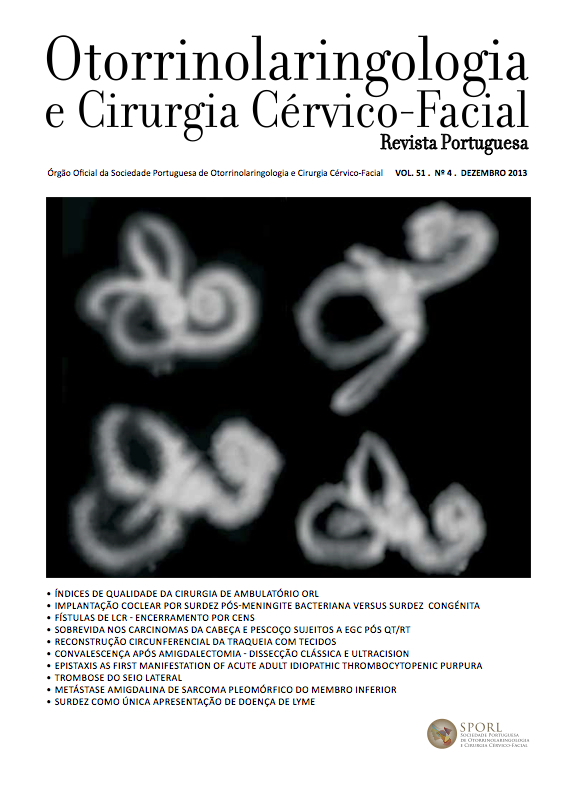Convalescence after tonsillectomy: comparative study between traditional dissection and with harmonic scalpel (Ultracision)
DOI:
https://doi.org/10.34631/sporl.49Keywords:
tonsillectomy, surgical technique, postoperative morbidityAbstract
Introduction: Tonsillectomy is one of the most frequent procedures in the pediatric population. Because there are several surgical techniques and they are associated with different morbidity, the decision on wich to use continues to engender significant debate. The aim of this work is to compare the postoperative morbidity between two different tonsillectomy techniques: traditional and harmonic scalpel dissection.
Material and methods: Retrospective study. Patients who underwent tonsillectomy in the Otorhinolaringology Department of Braga Hospital, Portugal, from July to December 2011, were alternately selected from traditional and harmonic scalpel dissection groups, a total of 40 patients of each group. Data relative to duration of hospitalization, immediate postoperative complications, day of introduction of normal diet, urgency admission till the 15th postoperative day, were collected and compared.
Results: 80 children, aged between 3 and 14 years old, average age of 6 years old, 56% female. 73 children underwent adenotonsillectomy and 7 underwent tonsillectomy. There were no complications during hospitalization and all children discharged the day after surgery. Significantly more children who underwent tonsillectomy by harmonic scalpel dissection (12/40 vs 1/40) were admitted to the urgency the days after surgery, because of pain or hemorrhage (p <0.05). The introduction of normal diet was also significantly later in the harmonic scalpel tonsillectomy group (average of 7 days vs 4 days) (p <0.05).
Conclusions: In this study, harmonic scalpel dissection was related to increased postoperative morbidity. It was found increased use of urgency consultation and later introduction of normal diet. Those factors are important regarding the choice of the tonsillectomy technique, especially in the pediatric population.
Downloads
References
Ramos FA, Ferreira RDP, Silva RH, Prado EP. Estudo Comparativo entre duas técnicas de tonsilectomia: bisturi harmônico e dissecção tradicional com bisturi de lâmina fria. Rev. Bras. Otorrinolaringol. 2004;70:316-22.
Maddern BR. Electrosurgery for Tonsillectomy. Laryngoscope. 2002;112(8):100-2.
Salomone R, Visioli AJ, Aquino MM, Takahashi EN, et al. Tesoura Curva Ultrassônica na Realização de Amigdalectomia: Ensaio Clínico Comparativo entre esta Nova Técnica Cirúrgica e a Técnica com Bisturi de Lâmina Fria. Arq. Int. Otorrinolaringol. São Paulo;2007;11(4):444-52.
Steward DL, Chung SJ. The role of adjuvant therapies and techniques in tonsillectomy. Curr opin otolaryngol. Head and neck surgery. 2000;8(3):186-92.
Akural EI, Koivunen PT, Teppo H, Alahuhta SM, et al. Posttonsillectomy pain: a prospective, randomized and double-blinded
study to compare an ultrasonically activated scapel technic with the blunt dissection technic. Aneaesthesia. 2001;56(11):1045-50.
Ochi K, Ohashi T, Sugiura N, Komatsuzaki Y, et al. Tonsillectomy Using an Ultrasonically Activated Scapel. Laryngoscope. 2000;110(7):1237-8.
Leach J, Mannings S, Scheefer S. Comparison on two methods of tonsillectomy. Laryngoscope. 1993;103:619-22.
Pang YT, El-Hakim H, Rothera MP. Bipolar diathermy tonsillectomy. Clin. Otolaryngol. 1992;19:355-7.
Lassaleta L, Martin G, Villafruela MA, Bolânos C, et al. Pediatric tonsillectomy: post-operative morbidity comparing microsurgical bipolar dissection versus cold sharp dissection. Int. J. Pediatric. Otolaryngol. 1997;41:307-17.
Tay HL. Post-op morbidity in electrodissection tonsillectomy. J. Laryngol. Otol. 1995;109:209-11.
Wilson JT, Murray A, Mackenzie K. Prospective study of morbidity after tonsillectomy in children. Int. J. Pediatr. Otolaryngol.
;58:119-25.
Silveira H, Soares JS, Lima HA. Tonsillectomy: cold dissection versus bipolar electrodissection. Int. J. Pediat. Otolaryngol. 2003;67:345-51.
MacGregor FB, Albert DM, Bhattacharyya AK. Post-operative morbidity following paediatric tonsillectomy; a comparison of bipolar diathermy dissection and blunt dissection. Int. J. Ped. Otolaryngol. 1995;3:1-6.
Raut VV, Bhat N, Sinnathuray AR, Stevenson M, et al. Bipolar scissors versus cold dissection for pediatric tonsillectomy - a prospective, randomized pilot study. Int. J. Ped. Otolaryngol. 2002;64:9-15.
Hesham A. Bipolar diathermy versus cold dissection in paediatric tonsillectomy. Int. J. Ped. Otolaryngol. 2009;73:793-5.
Andréa M. Microsurgical Bipolar Cautery Tonsilectomy. Laryngoscope. 1993; 103:1177-8.
Sood S, Corbridge R, Powles J, Bates G, et al. Effectiveness of the ultrasonic harmonic scalpel for tonsillectomy. ENT - Ear, nose & Throat Journal. 2001;514-8.
D´Avila JS, Neto JCT, Antunes A. Microcirurgia de tonsilas com bisturi ultracision. 2001;5(4):172-4.






